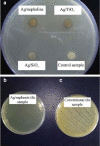Advances in Nanoarchitectonics of Antimicrobial Tiles and a Quest for Anti-SARS-CoV-2 Tiles
- PMID: 35599970
- PMCID: PMC9113380
- DOI: 10.1007/s10904-022-02325-w
Advances in Nanoarchitectonics of Antimicrobial Tiles and a Quest for Anti-SARS-CoV-2 Tiles
Abstract
Design of antimicrobial tiles seems necessary to combat against contagious diseases, especially COVID-19. In addition to personal hygiene, this technology facilitates public hygiene as antimicrobial tiles can be installed at hospitals, schools, banks, offices, lobbies, railway stations, etc. This review is primarily focused on preparing antimicrobial tiles using an antimicrobial layer or coatings that fight against germs. The salient features and working mechanisms of antimicrobial tiles are highlighted. This challenge is a component of the exploratory nature of nanoarchitectonics, that also extends farther than the realm of nanotechnology. This nanoarchitectonics has been successful at the laboratory scale as antimicrobial metal nanoparticles are mainly used as additives in preparing tiles. A detailed description of various materials for developing unique antimicrobial tiles is reported here. Pure metal (Ag, Zn) nanoparticles and a mixture of nanoparticles with other inorganic materials (SiO2,, TiO2, anatase, nepheline) have been predominantly used to combat microbes. The developed antimicrobial tiles have shown excellent activity against a wide range of Gram-positive and Gram-negative bacteria. The last section discussed a hypothetical overview of utilizing the antimicrobial tiles against SARS-CoV-2. Overall, this review gives descriptive knowledge about the importance of antimicrobial tiles to create a clean and sustainable environment.
Keywords: Anatase; Antimicrobial tiles; COVID-19; Ceramic tiles; Glaze; Nanoparticles; SARS-CoV-2.
© The Author(s), under exclusive licence to Springer Science+Business Media, LLC, part of Springer Nature 2022.
Conflict of interest statement
Conflict of interestThere are no conflicts to declare.
Figures







References
-
- Maksimov VN, Bulgakov NG, Milovanova GF, Levich AP. Determination analysis in ecosystems: contingencies for biotic and abiotic components. Biol. Bull.-Russ. Acad. Sci. 2000;27(4):405–413.
-
- C.K. Ahn, E. Klein, P.I. Tarr, Isolation of patients acutely infected with Escherichia coli O157: H7: low-tech, highly effective prevention of hemolytic uremic syndrome - PubMed
-
- Aislabie J, Deslippe JR, Dymond J. Soil microbes and their contribution to soil services. Ecosystem services in New Zealand–conditions and trends. Manaaki Whenua Press, Lincoln, New Zealand. 2013;1(12):143–161.
Publication types
LinkOut - more resources
Full Text Sources
Miscellaneous
